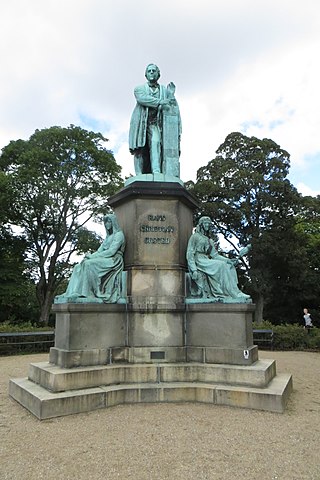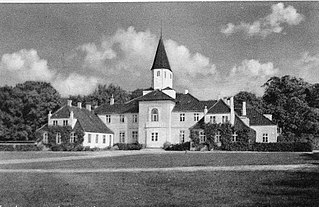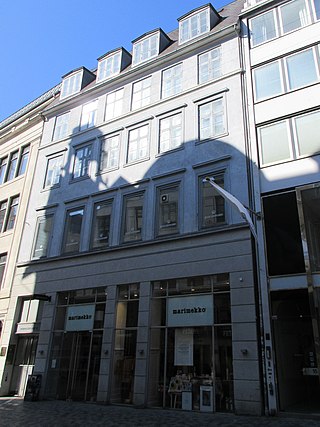

Jens Ernst Wegener (5 October 1781 - 15 October 1846) was a Danish educator and pedagogical writer. He was principal of Jonstrup Seminarium outside Copenhagen from 1819 to 1838. He was the father of painter Gustav Theodor Wegener.


Jens Ernst Wegener (5 October 1781 - 15 October 1846) was a Danish educator and pedagogical writer. He was principal of Jonstrup Seminarium outside Copenhagen from 1819 to 1838. He was the father of painter Gustav Theodor Wegener.
Wegener was born in Odense, the son of Casper Frederich Wegener and Maren Jensdatter Staal. [1] He later moved to Copenhagen.
Wegener succeeded Jacob Saxtorph as principal of Jonstrup Seminarium in 1819. He retired in 1838. [2] Hans Christian Andersen mentions him in Mit livs rejse. [2]
Wegener married Birgitte Maria Bindesbøll (1797–1856), a sister of the architect Michael Gottlieb Bindesbøll. They had four children: Karen Johanne Juliane Wegener, Gustav Theodor Wegener, Marie Sophie Lovise Lund and Jacobe Henriette Catharina Wegener. His daughter Johanne (Hanne) was married to the paper merchant and art collector Wilhelm Wanscher.

Albert Bertel Thorvaldsen was a Danish and Icelandic sculptor and medalist of international fame, who spent most of his life (1797–1838) in Italy. Thorvaldsen was born in Copenhagen into a working-class Danish/Icelandic family, and was accepted to the Royal Danish Academy of Art at the age of eleven. Working part-time with his father, who was a wood carver, Thorvaldsen won many honors and medals at the academy. He was awarded a stipend to travel to Rome and continue his education.

Assistens Cemetery in Copenhagen, Denmark, is the burial site of many Danish notables as well as an important greenspace in the Nørrebro district. Inaugurated in 1760, it was originally a burial site for the poor laid out to relieve the crowded graveyards inside the walled city, but during the Golden Age in the first half of the 19th century it became fashionable and many leading figures of the epoch, such as Hans Christian Andersen, Søren Kierkegaard, Christoffer Wilhelm Eckersberg, and Christen Købke are all buried here.

The Danish Golden Age covers a period of exceptional creative production in Denmark, especially during the first half of the 19th century. Although Copenhagen had suffered from fires, bombardment and national bankruptcy, the arts took on a new period of creativity catalysed by Romanticism from Germany. The period is probably most commonly associated with the Golden Age of Danish Painting from 1800 to around 1850 which encompasses the work of Christoffer Wilhelm Eckersberg and his students, including Wilhelm Bendz, Christen Købke, Martinus Rørbye, Constantin Hansen and Wilhelm Marstrand, as well as the sculpture of Bertel Thorvaldsen.

Michael Gottlieb Birckner Bindesbøll was a Danish architect active during the Danish Golden Age in the first half of the 19th century. Most known for his design of Thorvaldsens Museum in Copenhagen, he was a key figure in the stylistic shift in Danish architecture from late classicism to Historicism. He was the father of the designer Thorvald Bindesbøll and the textile artist Johanne Bindesbøll.

The Thorvaldsen Museum is a single-artist museum in Copenhagen, Denmark, dedicated to the art of Danish and Icelandic Neoclassical sculptor Bertel Thorvaldsen (1770–1844), who lived and worked in Rome for most of his life (1796–1838). The museum is located on the small island of Slotsholmen in central Copenhagen next to Christiansborg Palace. Designed by Michael Gottlieb Bindesbøll, the building was constructed from 1838 to 1848 following a public collection of funds in 1837.
Jonstrup is a suburban neighbourhood situated in Furesø Municipality on the west side of Hareskoven forest in the northwestern outskirts of Copenhagen, Denmark. The original village has merged with the neighbouring villages of Måløv in Ballerup Municipality and Smørumnedre in Egedal Municipality to form an urban agglomeration with a population of 21,353 (2023). The neighbourhood is separated from Måløv by Mølledalen, Møllemosen, and Værebro å.

Garrison Cemetery is a cemetery in Copenhagen, Denmark. It was inaugurated in 1671 on a site just outside the Eastern City Gate, as a military cemetery complementing the naval Holmens Cemetery which had been inaugurated a few years earlier on a neighbouring site. Later the cemetery was opened to civilian burials as well.

St. John's Church is a church located next to Sankt Hans Torv in the heart of the Nørrebro district of Copenhagen, Denmark. Opened in 1861, it was the first church to be built outside the city's old fortification ring when it was decommissioned and new residential neighbourhoods sprung up outside the former city gates.

Frederiksberg Ældre Kirkegård is a cemetery in Frederiksberg, Copenhagen. It was established in 1734 behind Frederiksberg Church.

The Physicist Hans Christian Ørsted is a monument to Hans Christian Ørsted located in Ørsted Park in central Copenhagen, Denmark.

Iselingen is a manor house and estate located close to Vordingborg on the southern part of Zealand in southeastern Denmark. It takes its name after the Swiss-born merchant Reinhard Iselin who established it in the 1770s. The current main building was completed a hundred years later to design by Vilhelm Dahlerup.

Skindergade 23 is a 19th-century property located on the southeast side of Skindergade, between Klosterstræde and Kejsergade, in the Old Town section of Copenhagen, Denmark.

Johanne Henriette Valentine Danneskiold-Samsøe née Kaas was a Danish countess who, when widowed, fulfilled her former husband's plans by founding the Holmegaard Glass Factory near Næstved in 1825. In so doing, she became one of Denmark's most notable early businesswomen. Danneskiold-Samsøe is also remembered for the correspondence she maintained with her former tutor Peder Deichmann.

HDMS Rota was a frigate of the Royal Danish Navy. She is above all remembered for being the ship that, in 1838, picked up the sculptor Bertel Thorvaldsen and many of his artworks in Livorno and brought them back to Denmark. Hans Dahlerup, her captain, and Alexander Wilde, then a junior lieutenant, have both described the voyage in their memoirs. In 1863, Rota was sold to H. Puggaard & Co. and converted into a civilian merchant ship. She wrecked off the coast of southern Norway in 1892, some ten years after being sold to Paul Larsen, Arendal.

Købmagergade 13 is an 18th-century townhouse situated on the shopping street Købmagergade, between Amagertorv and Valkendorfsgade, in central Copenhagen, Denmark. It was listed in the Danish registry of protected buildings and places in 1974. The complex consists of a four-storey building towards the street, two consecutive, half-timbered side wings along one side of a courtyard, a cross wing, separating the first and second courtyard from each other,, another half-timbered side wing along one side of the second courtyard, and two rear wings. Notable former residents include the businessmen Peter Pierre Tutein, Friederich Tutein and Peter van Gemmert, book printer Andreas Seidelin, educator Jens Ernst Wegener and architect Gottlieb Bindesbøll.

Wilhelm Wanscer was a Danish paper merchant and art collector, remembered above all for his associations with the philosopher Søren Kirkegård and some of the leading Danish Golden Age artists. He was the father of surgeon Oscar Wanscher and industrialist Axel Wanscher, grandfather of art historian Vilhelm Wanscher and great-grandfather of the designer Ole Wanscher.